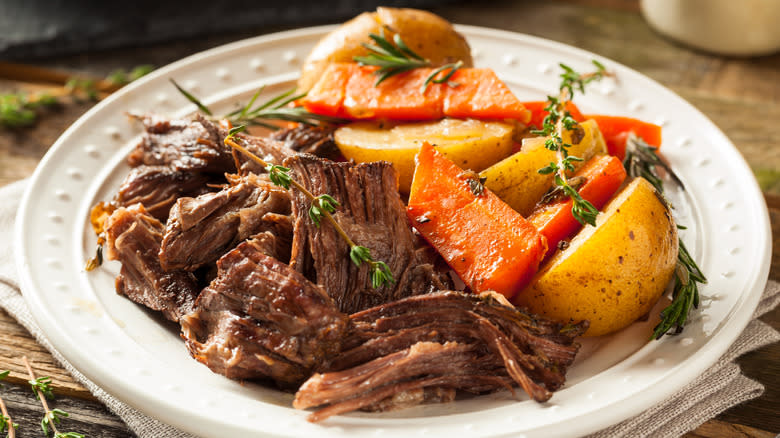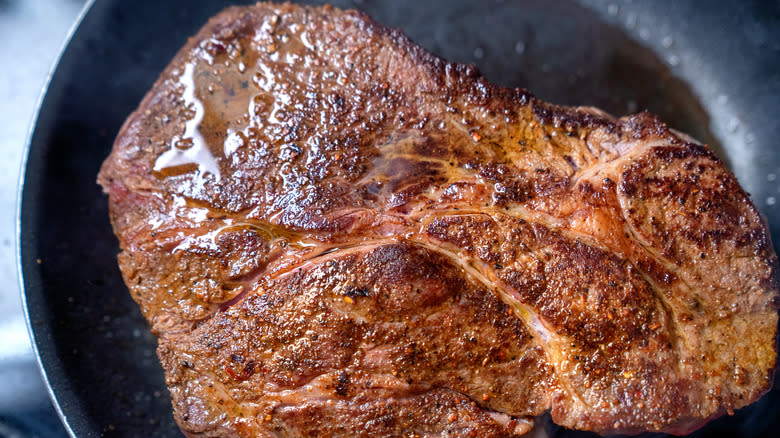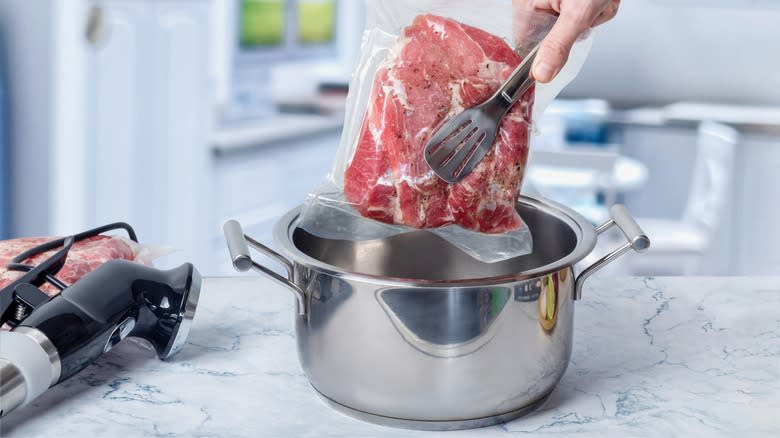The Case For Cooking Your Meat For A Full 24 Hours

The goal with any roast beef is that it be tender -- but this isn't always easy to accomplish. Traditionally tender cuts, like rib roast, can be overcooked; cheaper ones, like brisket or shank, are naturally chewy, to put it mildly. (It's easy to tell the difference between tender and tough cuts of meat if you know the rule.) The good news about anything traditionally called pot roast (top round, bottom round, rump, chuck, et cetera) is that they're less expensive and more flavorful than more tender cuts; the bad news is that they're notoriously tough. But fret not! There's a foolproof (if lengthy) method of cooking these roasts that (quite literally) renders them fall-apart tender and intensely flavorful. The technique is correctly called sous vide cooking, but think of it as an extended water bath.
The great thing about cooking a roast sous vide is that you can reach a relatively low target internal temperature and keep it there -- there's no worrying about shooting past this goal as you would inside a smoker or the oven. For the most delectable pot roast, you'll want to achieve an internal temperature of 130 degrees Fahrenheit and maintain it for a full 24 hours. Not only will the results be the most tender and flavorful you've ever tasted, but you can tell your dinner guests that you spent all day (and night) in the kitchen with a semi-straight face.
Read more: The 13 Best Steaks For Grilling
Really Low And Really Slow

The traditional method of cooking pot roasts is a long roast in a low oven -- say, around two-and-a-half hours at 225 degrees Fahrenheit. This accomplishes the goal of reaching an internal temperature of 130 degrees Fahrenheit -- but only at the very end of the cooking process. To maximize both flavor and tenderness, it's necessary to hold that temperature for an extended amount of time.
Why? Because fat is flavorful due to containing very delicious volatile compounds. What makes any cut of meat "tough" is collagen, the fat that connects muscle fibers. The more work a muscle gets, the more collagen will be present. Breaking this fat and muscle fiber down increases both flavor and tenderness, and this is done through natural enzymes (in beef they're known as calpains and cathepsins). Too high an internal temperature will kill them off, but keeping things at 130 degrees Fahrenheit will maximize enzymatic activity -- or, in this case, produce highly flavorful, fork-tender succulence.
Sous Vide To The Rescue

The only way to achieve and maintain this internal temperature with any kind of precision is by cooking the roast sous vide. That does not mean you need to leave it to the professionals, attend culinary school, or even learn to speak French to do this at home (the name translates to "under vacuum," by the way). All sous vide requires is that the protein (and whatever other flavoring adjuncts) be vacuum-sealed in a plastic bag and then immersed in a temperature-controlled water bath. No direct heat is ever involved. Whatever temperature your water is set to, that's the temperature your roast will achieve. When using the sous vide method, it's impossible to overcook anything.
Best of all, the concentrated flavors produced by the enzymatically-rendered fats stay inside the roast instead of evaporating in the oven. In the sense of enzymatic activity on protein, it turns out that this 24-hour sous vide method is no different from what happens when you dry-age beef for several weeks, so you're fully justified in considering it a time saver!
Read the original article on Daily Meal.

